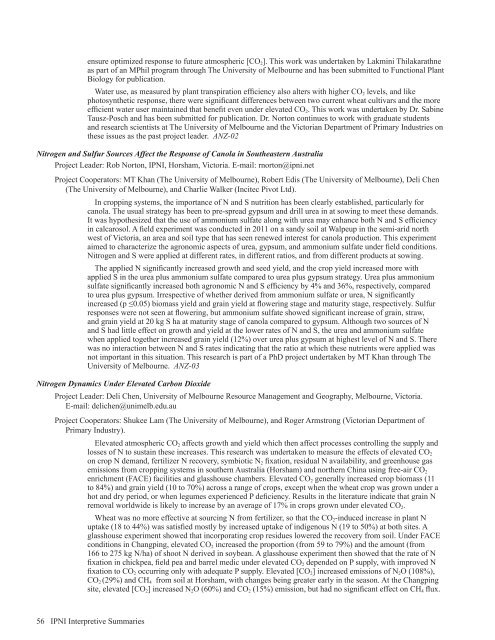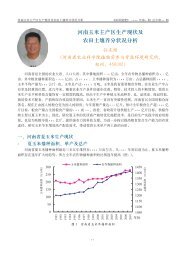Americas and Oceania Group - International Plant Nutrition Institute
Americas and Oceania Group - International Plant Nutrition Institute
Americas and Oceania Group - International Plant Nutrition Institute
You also want an ePaper? Increase the reach of your titles
YUMPU automatically turns print PDFs into web optimized ePapers that Google loves.
ensure optimized response to future atmospheric [CO 2 ]. This work was undertaken by Lakmini Thilakarathne<br />
as part of an MPhil program through The University of Melbourne <strong>and</strong> has been submitted to Functional <strong>Plant</strong><br />
Biology for publication.<br />
Water use, as measured by plant transpiration efficiency also alters with higher CO 2 levels, <strong>and</strong> like<br />
photosynthetic response, there were significant differences between two current wheat cultivars <strong>and</strong> the more<br />
efficient water user maintained that benefit even under elevated CO 2 . This work was undertaken by Dr. Sabine<br />
Tausz-Posch <strong>and</strong> has been submitted for publication. Dr. Norton continues to work with graduate students<br />
<strong>and</strong> research scientists at The University of Melbourne <strong>and</strong> the Victorian Department of Primary Industries on<br />
these issues as the past project leader. ANZ-02<br />
Nitrogen <strong>and</strong> Sulfur Sources Affect the Response of Canola in Southeastern Australia<br />
Project Leader: Rob Norton, IPNI, Horsham, Victoria. E-mail: rnorton@ipni.net<br />
Project Cooperators: MT Khan (The University of Melbourne), Robert Edis (The University of Melbourne), Deli Chen<br />
(The University of Melbourne), <strong>and</strong> Charlie Walker (Incitec Pivot Ltd).<br />
In cropping systems, the importance of N <strong>and</strong> S nutrition has been clearly established, particularly for<br />
canola. The usual strategy has been to pre-spread gypsum <strong>and</strong> drill urea in at sowing to meet these dem<strong>and</strong>s.<br />
It was hypothesized that the use of ammonium sulfate along with urea may enhance both N <strong>and</strong> S efficiency<br />
in calcarosol. A field experiment was conducted in 2011 on a s<strong>and</strong>y soil at Walpeup in the semi-arid north<br />
west of Victoria, an area <strong>and</strong> soil type that has seen renewed interest for canola production. This experiment<br />
aimed to characterize the agronomic aspects of urea, gypsum, <strong>and</strong> ammonium sulfate under field conditions.<br />
Nitrogen <strong>and</strong> S were applied at different rates, in different ratios, <strong>and</strong> from different products at sowing.<br />
The applied N significantly increased growth <strong>and</strong> seed yield, <strong>and</strong> the crop yield increased more with<br />
applied S in the urea plus ammonium sulfate compared to urea plus gypsum strategy. Urea plus ammonium<br />
sulfate significantly increased both agronomic N <strong>and</strong> S efficiency by 4% <strong>and</strong> 36%, respectively, compared<br />
to urea plus gypsum. Irrespective of whether derived from ammonium sulfate or urea, N significantly<br />
increased (p ≤0.05) biomass yield <strong>and</strong> grain yield at flowering stage <strong>and</strong> maturity stage, respectively. Sulfur<br />
responses were not seen at flowering, but ammonium sulfate showed significant increase of grain, straw,<br />
<strong>and</strong> grain yield at 20 kg S ha at maturity stage of canola compared to gypsum. Although two sources of N<br />
<strong>and</strong> S had little effect on growth <strong>and</strong> yield at the lower rates of N <strong>and</strong> S, the urea <strong>and</strong> ammonium sulfate<br />
when applied together increased grain yield (12%) over urea plus gypsum at highest level of N <strong>and</strong> S. There<br />
was no interaction between N <strong>and</strong> S rates indicating that the ratio at which these nutrients were applied was<br />
not important in this situation. This research is part of a PhD project undertaken by MT Khan through The<br />
University of Melbourne. ANZ-03<br />
Nitrogen Dynamics Under Elevated Carbon Dioxide<br />
Project Leader: Deli Chen, University of Melbourne Resource Management <strong>and</strong> Geography, Melbourne, Victoria.<br />
E-mail: delichen@unimelb.edu.au<br />
Project Cooperators: Shukee Lam (The University of Melbourne), <strong>and</strong> Roger Armstrong (Victorian Department of<br />
Primary Industry).<br />
Elevated atmospheric CO 2 affects growth <strong>and</strong> yield which then affect processes controlling the supply <strong>and</strong><br />
losses of N to sustain these increases. This research was undertaken to measure the effects of elevated CO 2<br />
on crop N dem<strong>and</strong>, fertilizer N recovery, symbiotic N 2 fixation, residual N availability, <strong>and</strong> greenhouse gas<br />
emissions from cropping systems in southern Australia (Horsham) <strong>and</strong> northern China using free-air CO 2<br />
enrichment (FACE) facilities <strong>and</strong> glasshouse chambers. Elevated CO 2 generally increased crop biomass (11<br />
to 84%) <strong>and</strong> grain yield (10 to 70%) across a range of crops, except when the wheat crop was grown under a<br />
hot <strong>and</strong> dry period, or when legumes experienced P deficiency. Results in the literature indicate that grain N<br />
removal worldwide is likely to increase by an average of 17% in crops grown under elevated CO 2 .<br />
Wheat was no more effective at sourcing N from fertilizer, so that the CO 2 -induced increase in plant N<br />
uptake (18 to 44%) was satisfied mostly by increased uptake of indigenous N (19 to 50%) at both sites. A<br />
glasshouse experiment showed that incorporating crop residues lowered the recovery from soil. Under FACE<br />
conditions in Changping, elevated CO 2 increased the proportion (from 59 to 79%) <strong>and</strong> the amount (from<br />
166 to 275 kg N/ha) of shoot N derived in soybean. A glasshouse experiment then showed that the rate of N<br />
fixation in chickpea, field pea <strong>and</strong> barrel medic under elevated CO 2 depended on P supply, with improved N<br />
fixation to CO 2 occurring only with adequate P supply. Elevated [CO 2 ] increased emissions of N 2 O (108%),<br />
CO 2 (29%) <strong>and</strong> CH 4 from soil at Horsham, with changes being greater early in the season. At the Changping<br />
site, elevated [CO 2 ] increased N 2 O (60%) <strong>and</strong> CO 2 (15%) emission, but had no significant effect on CH 4 flux.<br />
56 IPNI Interpretive Summaries

















